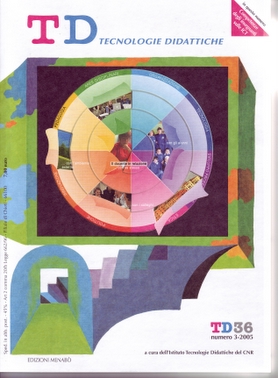Cooperative online learning: a possible methodological approach to the management of online university courses
Main Article Content
Abstract
Article Details
Section
Authors who publish with this journal agree to the following terms:
- Authors retain copyright and grant the journal right of first publication with the work simultaneously licensed under a Creative Commons CC BY 4.0 Attribution 4.0 International License.
- Authors are able to enter into separate, additional contractual arrangements for the non-exclusive distribution of the journal's published version of the work (e.g., post it to an institutional repository or publish it in a book), with an acknowledgement of its initial publication in this journal.
- Authors are permitted and encouraged to post their work online (e.g., in institutional repositories or on their website) prior to and during the submission process, as it can lead to productive exchanges, as well as earlier and greater citation of published work (See The Effect of Open Access)
References
Barron B. (2000), Achieving coordination in collaborative problemsolving groups, The Journal of the Learning Sciences, n. 9, pp. 403- 436.
Benigno V., Trentin G. (2000), An approach to the evaluation of online courses, International Journal of Computer Assisted Learning, vol. 16, n.3, pp. 259-270.
Berge Z.L. (1995), Facilitating computer conferencing: reccomendations from the field, Educational Technology, vol. 35, n. 1, pp. 22-29.
Brounstein M. (2002), Managing Teams For Dummies, Hungry Minds Inc.
Collins B., Van der Wende M. (2002), Models of technology and change in higher education: an international comparative survey on the current and future use of ICT in higher education (Report), Enschede, The Netherlands: University of Twente, Center for Higher Education Policy Studies.
Denis B., Watland P., Pirotte S., Verday, N. (2004), Roles and competences of e-tutor, Proceedings of Networked Learning Conference 2004. Accessibile alla pagina: http://www.shef.ac.uk/nlc2004/ Proceedings/Symposia/Symposium6/ Denis_et_al.htm
Earl S. E. (1986), Staff and peer assessment–measuring an individual’s contribution to group performance, Assessment and Evaluation in Higher Education, vol. 11, n. 1, pp. 60-69.
Felder R., Brent E. (2001), Effective strategies for cooperative learning, Journal of Cooperation and Collaboration in College Teaching, vol. 10, n. 2, pp. 66-75.
Foundation Coalition (2002), Peer assessment e peer evaluation. Accessibile alla pagina: http://www.foundationcoalition. org/publications/brochures/ 2002peer_assessment.pdf
Fuller D., Norby R.F. (2000), Internet teaching by style: profiling the on-line professor, Educational Technology, vol. 3, n. 2, pp. 65-72.
Gunawardena C.N. (1995), Social presence theory and implications for interaction and collaborative learning in computer conference, International Journal of Educational Telecommunications, vol. 1, n. 2/3, pp. 147-166.
Harasim L.M. (1990), Online education: perspectives on a new environment, Praeger, New York, 1990.
Haughey M., Anderson T. (1998), Networked learning: the pedagogy of the Internet, Toronto: Mc- Graw-Hill.
Hazemi R., Hailes S. (2002), Introduction. In R. Hazemi e S. Hailes (Eds.), The Digital University: Building a Learning Community, London: Springer.
Hiltz S. R., Turoff, M. (2002), What makes learning networks effective? Communications of the ACM, vol. 45, n. 4, pp. 56-59.
Kaye A. (1994), Apprendimento collaborativo basato sul computer, TD – Rivista di Tecnologie Didattiche, n. 4, 1994, pp. 9-21, Menabò, Ortona.
Keegan D. (1994), Principi di istruzione a distanza, La Nuova Italia, Firenze.
Kiesler S., Siegel J., McGuire T. (1984), Social psychological aspects of computer-mediatedcommunication, American Psychologist, vol. 39, n 10, pp. 1123- 1134.
Laurillard D. (1993), Rethinking university teaching, Routledge, London.
Leh, A.S.C. (2001), Computermediated communication and social presence in a distance learning environment, International Journal of Educational Telecommunications, vol. 7, n. 2, 2001, pp. 109-128.
Palloff, R. M., & Pratt, K. (2002), Beyond the looking glass: what faculty and students need to be successful online. In K. E. Rudestam e J. Schoenholtz-Read (Eds.), Handbook of Online Learning: Innovations in Higher Education and Corporate Training, pp. 171-184. Thousand Oaks, CA: Sage.
Ravet S. (2003), E-learning and knowledge management, The Newsletter of the Prometeus Network, n. 20. Accessibile alla pagina http://www.prometeus.org.
TEL Committee, University of Texas (2004) Report of Technology Enhanced Learning Committee. Accessibile alla pagina: http://www.utexas.edu/provost/ planning/reports/TEL_Report_ 2004.pdf.
Trentin G. (2001), Dalla formazione a distanza all’apprendimento in rete, Franco Angeli, Milano.
Trentin G. (2004), Networked Collaborative Learning in the Study of Modern History and Literature, Computers and the Humanities , vol. 38, pp. 299-315.
Trentin G. (2005), From “formal” to “informal” e-Learning through knowledge management and sharing, Journal of e-Learning and Knowledge Society, vol. 1, n. 2, pp. 209-217.
Trentin G. (2006), E-Learning and Teaching Quality, International Journal of Instructional Media, vol. 35, n. 1, printing.
Young J. R. (2002), ‘Hybrid’ teaching seeks to end the divide between traditional and online instruction, Chronicle of Higher Education. Accessibile alla pagina: http://chronicle.com/free/v48 /i28/28a03301.htm

